Wildlife Colourscapes
Wildlife travel is one of the most popular travel trends, with wildlife holidays proving to be more popular than beach holidays last year. At Ampersand Travel, tailor-made wildlife holidays are a huge part of our offering with magnificent wildlife and safari holidays available across Africa and Asia. And of course, a safari holiday is not the only way in which to explore a country’s wildlife. Outside the most common safari destinations, unique wildlife can be explored around the world, from whale watching in Sri Lanka to bear spotting in the USA and Canada.
One striking aspect of wildlife travel is that wherever you visit, you are sure to see unique animals and nature which give each destination its own identity. This is what inspired us to create our new Wildlife Colourscapes, showcasing the varied and vibrant colours which different country’s wildlife bring to their identity.
Browse our Wildlife Colourscapes collection below to find out more about the wildlife in different countries around the world, and how each country’s wildlife creates a distinct colourscape.
Antarctica
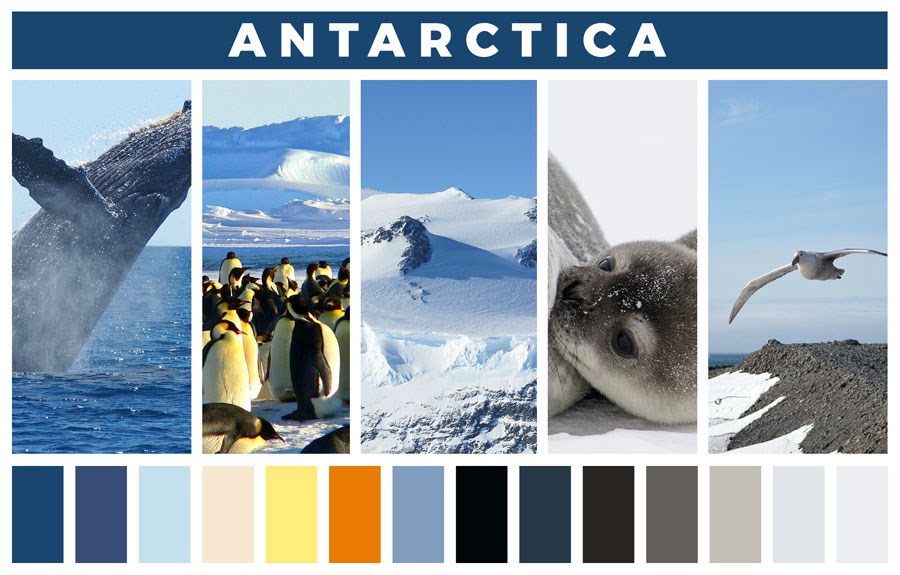
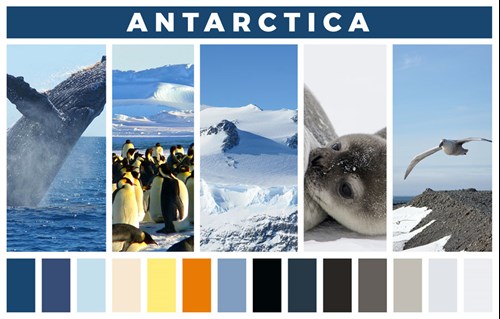
Antarctica’s colour palette is an array of cool blues and greys, given that almost the entire country and continent is covered with ice and snow. The beautiful collection of blues, greys and whites, with just a hint of orange from the penguins’ plumes, emits an atmosphere of calm and peacefulness.
The palette includes colours taken from emperor penguins, giant petrels, the humpback whale and leopard seals, as well as the sweeping glacial landscape. Despite the alarmingly cold and difficult conditions, there is a surprising amount of wildlife in Antarctica which thrives even in the harshest of conditions.
Among the impressive animals that dot the Antarctic landscape are the emperor penguins, the largest living penguin that can grow to approximately 115cm, nearly 4 feet tall. Synonymous with Antarctica, these penguins are slowly making their way onto the endangered animals list, largely due to the melting icecaps. Emperor penguins rely on the ice to find krill, their main food source, and it’s predicted that by the end of the 21st century the population size will have dwindled by at least two-thirds. Today, roughly 60,000 of these amazing animals still exist in the wild, and they provide a vital role in the food chain; their extinction will have a massive effect on the population of leopard seals, the emperor penguins main predator, and in turn this will affect the population of larger animals, such as killer whales.
Australia
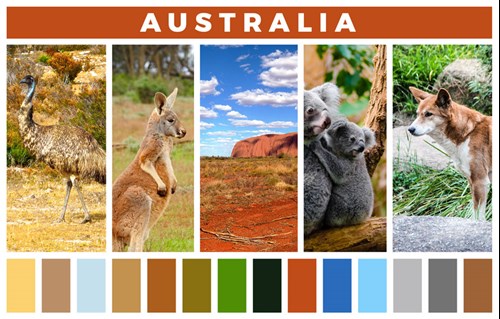
Home of Ayers Rock and the infamous Australian outback, Australia’s colourscape is ripe with oranges, reds and browns. From the country’s national animals of the kangaroo and the emu, to the iconic dingo and koala bear, the earthy tones are broken only by the bright injection of the blue sky.
Australians are proud of their national animals, representing them across coinage and mascots at national sporting events, and it’s no wonder when a lot of them are incredibly cute. The koala, for instance, with fluffy ears, big eyes, cuddly body, sleeps for 20 hours a day, what’s not to love? Unfortunately, koalas have recently been listed as ‘functionally extinct’, which means there isn’t enough of the population in the wild left to support the next generation. The main reason for this is climate change, which has resulted in soaring temperatures, and mass deforestation which has occurred in their habitats. Today, only 80,000 koalas are left in Australia.
Brazil
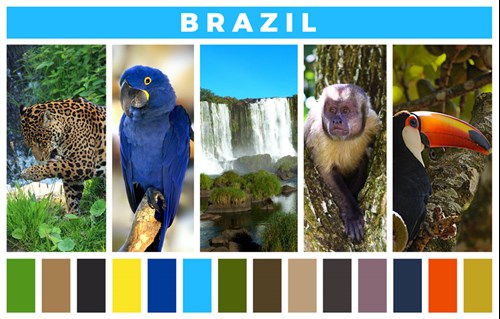
Two iconic pillars of Brazilian culture are the Amazon Rainforest and the Rio Carnival, so it’s no surprise that a colourscape of its wildlife and landscape perfectly showcases that vibrant colour palette. The country is vast and supports a rich biodiversity where several interesting species can thrive, such as the impressive jaguar, the capuchin monkey, blue macaw and even the pink dolphin.
Despite the variety of wildlife and the sheer size of the country, Brazil is still susceptible to some important factors which are affecting the native animals, such as climate change, human activity and, most importantly, deforestation. For instance, the blue macaw, officially named the Hyacinth macaw, is considered vulnerable and endangered, largely due to the cage bird trade and habitat loss. Similarly, the jaguar is an incredibly difficult animal to spot, with a rapidly decreasing population. A number of travellers every year are allowed to spend time with jaguar researchers at the Mamiraua Reserve, where there is one of the world’s densest concentrations of the cat, and there is a big focus on the conservation effort and attempts to rescue them from extinction.
Canada
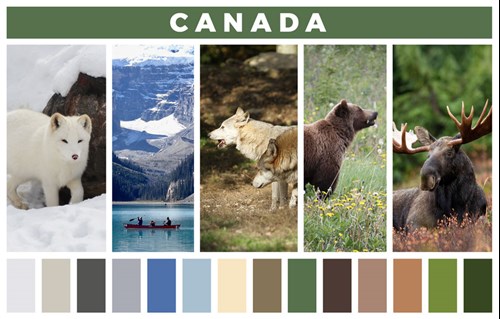
Canada’s rich and varied landscape includes the Rocky Mountains, Arctic tundra, the prairies and boreal forest, which, combined with the varied wildlife, creates an interesting colour palette. From pristine whites and cool blues of the icy landscape, to the earthy browns and verdant greens of the forests and prairies.
The most notable animals from Canada include the arctic fox, the grizzly bear, the moose (Canada’s national animal) and the timber wolves. The Arctic fox isn’t technically on the endangered list yet, but its prime habitats are the snowy, wintry landscapes across the north of Canada, meaning that it’s susceptible to climate change. Relying on its white coat as camouflage, the rapid loss of ice and snow makes it harder for it to hunt for its prey, as does the rapid loss of sea and marine life.
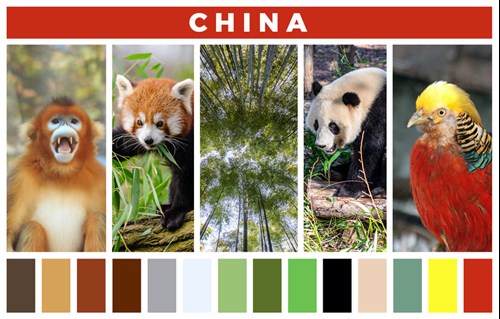
China is an exceptionally large landmass and is home to an impressive variety of wildlife. One of the most colourful colour palettes from the countries we’ve looked at, China’s colourscape includes the iconic giant panda, a bamboo field, the red panda, a Chinese pheasant and a golden snub-nosed monkey, many of which are endemic to China. With over 562 species of mammals, 346 amphibians, 4,936 species of fish and 403 reptile species, it wasn’t easy narrowing down the colourscape, but the colours are simply breath-taking.
The golden snub-nosed monkey is one such species that can only be found in China, specially, it can only be found in the southwest and central regions of the country. Incredibly rare, the monkey has been declared endangered with an actively decreasing population, mostly due to the destruction of its already minute habitat. Similarly, the giant panda has been classified as vulnerable, although this has largely improved since 2015 when the population size grew by 16.8%. Part of the bear family, the giant panda is instantly recognisable thanks to the unique black and white markings of its fur.
Costa Rica
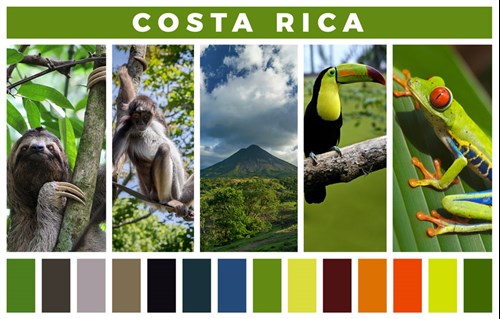
Costa Rica is home to over 500,000 different animal species, placing it in the top 20 most biodiverse countries in the world. With 32 national parks, 51 wildlife refuges, 13 forest reserves and eight biological reserves, there are plenty of places to visit and witness the incredible wildlife in its natural habitat. Some of the most fascinating include the Costa Rican toucan, the colourful tree frog, the much-loved sloth and the spider monkey, all of which combine with the rich green landscape to create a tropical and bright colour palette.
One of the most bizarre animals you could find in Costa Rica, the three-toed sloth, is known to be critically endangered as a result of mass deforestation of the tropical rainforests across the South American continent. Integral parts of the tropical rain forest ecosystem, sloths are famously slow-moving and live high up in the trees almost all the time.
Another interesting creature to be found in Costa Rica is the red-eyed tree frog, which utilises its coloured eyes to temporarily shock and paralyse its predators. Although they aren’t currently on the endangered species list, their population is slowly decreasing, again as a result of deforestation and human activity.
Galapagos
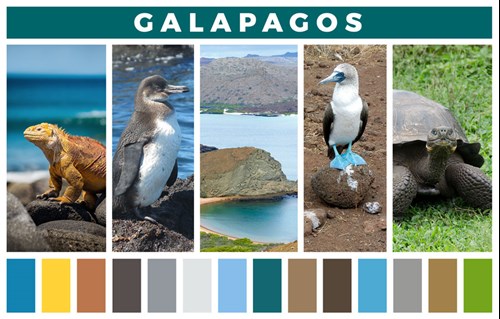
The Galapagos is a selection of islands roughly 600 miles off the southern coast of Ecuador, and home to more than 200 species unique to the islands. Once a favoured spot for pirates, the islands were considered cursed for a long time, and it was this that allowed the unique species to develop and thrive, despite the harsh conditions.
Over 97% of the archipelago is preserved as a national park, and as a result, the islands are one of the world’s most unspoiled UNESCO Natural Heritage sites.
Given their island status, it’s unsurprising that a lot of the wildlife in the Galapagos heavily features blue and green in its colouring. From the blue footed booby to the native iguana, penguin and famous Galapagos tortoise, the colour palette created from these islands is very heavily reminiscent of a paradise found at the end of the world.
Despite the heavily protected nature of the islands, many indigenous creatures are still at risk. For example, of the 15 tortoise species found on the island, six are critically endangered, three are endangered, three are vulnerable and two are extinct. The marine iguana is similarly facing threats and is now considered vulnerable; the introduction of domestic cats and dogs by the few human populations who live on the islands, has greatly affected the number of iguanas, as has the influx or marine plastic pollution.
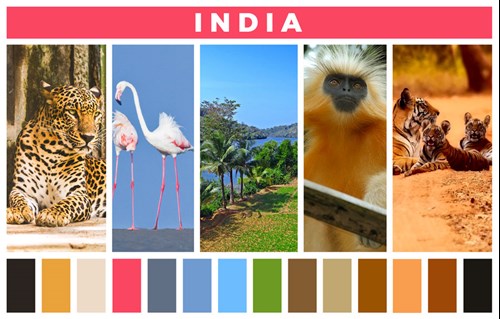
India’s incredible wildlife is spread across over 100 national parks, with approximately 15,600 square miles of protected land. While it is the iconic Bengal tiger that often attracts travellers to an Indian safari, there are so many more incredible animals dotted amongst India’s forests, grasslands, rivers and mountains. That’s why India’s colourscape is so vibrant: with the pink of the flamingos, the earthy colours of a leopard, the orange of the tigers and golden langur, and the bright blues and greens of the landscape, it’s quite spectacular.
India is a country very at risk from climate change and human activity such as deforestation, which is having a devastating impact on the environment and the wildlife. As a result, a number of the most iconic animals from India are on the endangered list, including the Bengal tiger, golden langur and the leopard. The leopard is threatened due to the increase in deforestation, and hunting continues to threaten its survival. This is the same for the Bengal tiger. The golden langur is one of the most endangered primate species in India, with a rapidly decreasing population size due to the number of infants that die at a young age before reproducing, and due to their habitat disappearing.
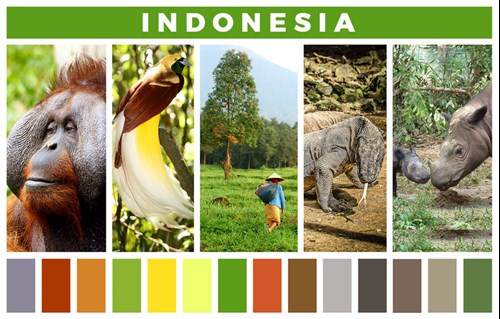
Indonesia is a fantastically diverse archipelago, both in terms of the landscape and the wildlife that resides here. From great apes, tigers, elephants and monkeys, to the famous Komodo dragon and the incredibly endangered Sumatran rhino. Indonesia is made up of over 17,000 islands, with mountains and thick forests covering the majority, and the biodiversity here has created ecosystems virtually isolated from outside influences and factors, meaning it is home to some extreme conditions.
One such creature that has managed to survive Indonesia’s often harsh and difficult climate, is the Komodo dragon, the world’s largest lizard that is currently on the endangered list (despite the fact that it can kill animals the size of buffalos with the bacteria in their toxic bites). Another fantastic animal from Indonesia that is currently endangered is the Cenderawasih bird, which is brightly coloured with a great plume of yellow feathers, and the Sumatran rhino which is critically endangered with less than 80 currently surviving in the wild. This is a result of poaching, which has caused the population to decline by up to 70% over the last 20 years.
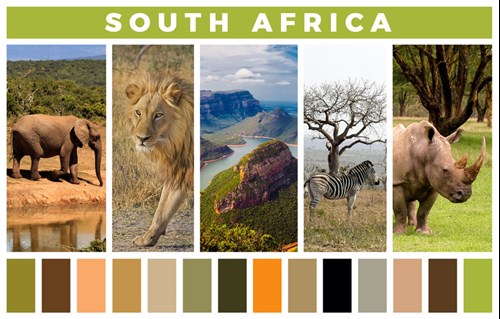
South Africa is a true wildlife gem of the world; right on the southern tip of the African continent, the South African landscape covers an abundance of different ecological systems, from dense green forests to arid desert, making it ideal for a number of species to thrive here. South Africa's most iconic animals are the Big Five: lions, elephants, rhinos, leopards and buffalo. As a result, the South African colourscape is a selection of dusty browns and oranges, with the occasional burst of colour from the bight grassland.
South African animals are well-known for their endangered status; their rapidly decreasing population has prompted a surge in conservation efforts all over the globe. The African lion, for instance, is categorised as “vulnerable”, while the various species of zebra that can be found across South Africa, such as the Grevy’s zebra, are subject to a declining population. The African elephant is similar, with many of the majestic creatures being poached for the ivory trade.
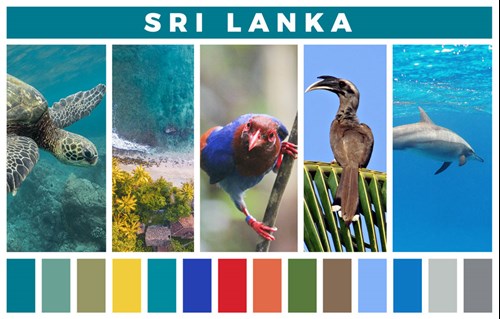
Sri Lanka might be a fairly small country, but it’s by far one of the best places in Asia to see an abundance of wildlife. With a mix of big game and marine life, as well the varied landscapes and the country’s wide range of altitudes, Sri Lanka has the same varied biodiversity one would typically expect from an entire continent. Its island status means that it is home to a variety of fantastic marine life, such as the sea turtle and spinner dolphin, while the jungle forests have created the perfect habitat for birdlife, creating a colourscape full of bright blues and greens.
One of Sri Lanka’s most impressive creatures is the native grey hornbill, which differs from other hornbills owing to its beak. Another is the spinner dolphin, named so for its acrobatic displays as it jumps and spins through the air, as well as the sea turtle, which has been classified as endangered; the beautiful animals are hunted for their eggs, meat, skin and shells, suffering from poaching and over-exploitation. In addition, the volume of plastic pollution in the ocean has caused their habitats to be damaged and destroyed.
Switzerland
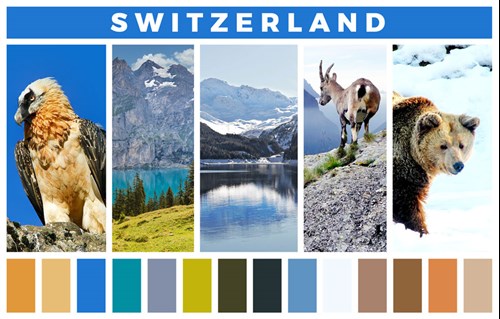
Switzerland is one Alpine country where the wildlife is thriving, despite having decimated the animals over the last few centuries, as much of Europe has done over the years. The country is flourishing with diverse animals and landscapes, from the beautifully iconic golden eagle to the grizzly bear and chamois, which can be found across the snowy mountains and rich green valleys.
The brown bear is one of the most exciting animals to spot in the wilderness of Switzerland. Officially declared extinct for almost a century, after the last brown bear was killed in 1904, incredible conservation efforts have brought this bear back, with the species now categorised as endangered with a population largely on the rise. Another endangered animal is the chamois; although never officially declared extinct, the chamois is a large animal of Switzerland that has teetered on the brink for the past century, with low population numbers. However, like the brown bear, the animals are slowly coming back, with roughly 1,700 roaming the Swiss mountains.
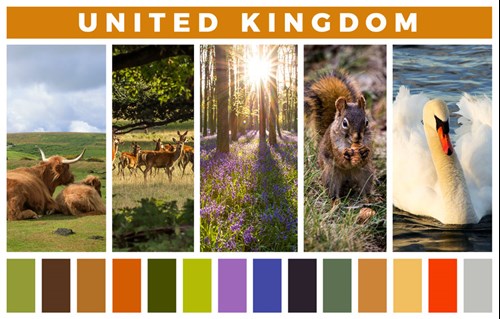
The UK is home to a number of different species of animals, including some that are very distinctly British, such as the red squirrel. A number of native British species are fairly common, such as the cow, but there are some which are still enjoyable to spot in the wild, the swan, for instance, the entire population of which technically belongs to the Queen. From the bright orange beak of the swan, to the purple and green wild heather fields, the red deer and the rolling hills of the countryside, the UK’s colourscape is varied and bright.
Unfortunately, there are a number of factors that are affecting the UK’s environment and causing the slow decline of a number of native species, such as the red squirrel. The main problem is the continued rise of agricultural demands on the environment; agriculture accounts for over 70% of land use in the UK, which has caused soil health to deteriorate and several farmland bird species to become affected.
USA
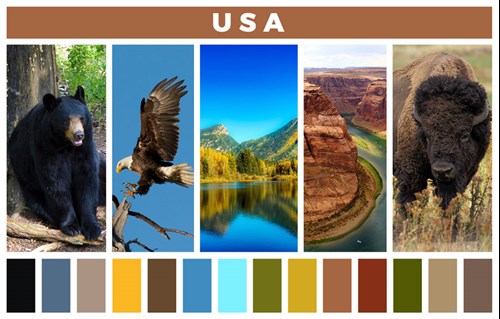
The USA is an immense country, spanning over nine million kilometres squared, and with it, an impressive array of wildlife. The country is inclusive of mammals, reptiles, insects, birds, big cats and more, with surrounding islands and sea containing indigenous wildlife such as the grey wolf, American black bear, white tailed deer and the endangered lynx. From the vivid landscape of the eye-catching Grand Canyon, to the earthy browns and blacks of the native black bear and bison and the majestic bright yellow orange of the bald eagle, the USA’s national animal, the country is alive with colour.
The bald eagle is a conservation success story that has emerged from the USA. Decades ago, the bald eagle was close to disappearing completely from the country, but thanks to conservation efforts the population is now flourishing, and it no longer has a spot on the endangered species list. Unfortunately, the same cannot be said for the American bison, which is on the endangered list after being brought to near extinction by hunting during the 19th century.
For more information, or to start planning your next wildlife holiday, please contact us:
info@ampersandtravel.com // +44 (0) 207 819 9770




